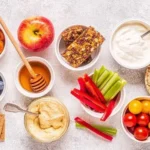Protein is an important nutrient for the human body and is a vital building block of body tissue. Proteins function as excellent sources of fuel and are perfect to keep energy and activity levels high. They not only play a major role in muscle building and repair but also transport and store nutrients, balance fluids and support biochemical reactions along with growth of the body.
Having said that, not everyone requires the same amount of protein in their diet. Based on age, gender, activity levels, and other factors, individuals require different amounts of protein. In addition, certain life stages such as pregnancy, adolescence, and infancy require higher levels of proteins for growth and development.
There are many foods that provide protein in our diet. Eating a greater variety of protein-rich foods can improve your health and improve conditions like high blood pressure, Diabetes, PCOS and Thyroid. When it comes to weight loss, this nutrient helps in providing satiety and curbs unwanted cravings which contribute to additional calories which add up to the weight. Most meals should contain at least 10 grams of protein per meal. The reason being, this will balance blood sugar levels, while also supplying amino acids to the neurotransmitters that help your nervous system function. Protein is also helpful for efficient digestion. It can give you sustained energy throughout the day by boosting metabolism. Not enough protein will leave you hungry shortly after a meal while eating too much might actually cause digestive upset and can release too much insulin in the body. Therefore it is important to balance protein with other nutrients as well.
Here are foods you should regularly consider including in your meals, in order to get roughly
10 grams of protein:
- Lentils
Hundred grams of lentil gives about 9g of protein. Lentils are legumes that are packed with
protein and other nutrients like iron, potassium, folate and fiber. They can be a part of soups, curries, salads. In addition, they are affordable, shelf-stable and cook more quickly than other dried beans. - Soy and it’s products
Soya granules, Tofu, Tempeh, Edamames are complete sources of protein and can be a good replacement for meat. They add about 10- 12 grams of protein per 100 grams. People can make stir fry, add them to soups, noodles and pulao. - Paneer
Also known as cottage cheese, this food is good to include to help boost your protein intake. It can be topped on salads, pan fried with veggies, made into a scramble and added to porridges or pulaos, depending on your preferences. 100 grams of paneer gives around 18 grams of protein. - Yoghurt
This versatile food can be a part of both savory and sweet based dishes. It can become the
base of a smoothie, can be added to overnight oats, fruit bowls and salad dressings. It is easily available and a quick ingredient to include in your meals. 100 gram of yogurt gives about 4 grams of protein, So it’s best to include about 200 grams of yogurt to your meal. - Eggs
Eggs are another source of complete protein. It’s best to add 2 full eggs to get 12 grams of
protein. You can add an egg (or two) to a salad or snack plate for a protein boost. Enjoy a
vegetable omelet with multigrain bread. They can even be used to make high-protein
pancakes. Adding eggs to your eating pattern is a healthy, affordable way to get protein. - Fish
Eating fish not only provides complete protein, but also serves a lot of benefits. One of the
biggest benefits being Omega-3 fatty acids, which our body cannot produce naturally.
Omega-3 is known to reduce inflammation and stress levels in the body, which can contribute to weight gain.
While protein helps promote satiety, eating fish can help people stay fuller for a longer
duration, as compared to other forms of protein. It is a good kind of lean meat which is also
good to boost athletic performance, build muscles and sustain energy levels in the body. 100 grams of fish provides 22 grams of protein. However, some varieties of fish can also have high-fat content, so you should be careful about the type of fish you are consuming.
7. Chicken
Chicken is a great substitute for red meat. The lean protein in chicken is an excellent source of amino acids. Studies have also shown that higher protein intake helps to maintain bone mineral density. 100 grams of chicken provides 23 grams of protein. Eating chicken can help to build stronger muscles and promote healthier bones, decreasing the risk of injuries and diseases such as osteoporosis.
What’s your favorite protein food to add to your meal and snacks ?






